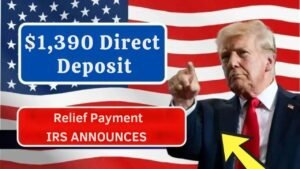Millions of Americans are preparing to receive a $2,000 direct deposit this November 2025, providing a timely financial boost during a period of rising living costs. The U.S. government has announced this one-time payment to help citizens cover essential expenses, including rent, groceries, utilities, and healthcare. Managed directly by the Internal Revenue Service (IRS), the program is designed to deliver funds efficiently without requiring separate applications.
This guide explains the key details, eligibility criteria, payment timeline, and steps to ensure you receive your payment on time.
What Is the $2,000 Direct Deposit Program?
The $2,000 direct deposit is a federal relief measure aimed at helping Americans manage financial pressures caused by inflation. While not officially labeled a “stimulus check,” it functions similarly, providing one-time support directly to eligible individuals.
Key highlights of the program:
- Funds are automatically deposited into eligible citizens’ bank accounts.
- Beneficiaries of Social Security, SSI, SSDI, VA, and other federal programs are included automatically.
- The program uses 2023 or 2024 tax records to determine eligibility and payment amounts.
- Payments are non-taxable and do not affect other federal benefits.
Eligibility Criteria
To qualify for the $2,000 payment, recipients must meet the following requirements:
- Citizenship: U.S. citizens, lawful permanent residents, or individuals with valid Social Security Numbers/Taxpayer Identification Numbers.
- Income Limits:
- Single filers: up to $75,000
- Heads of household: up to $112,500
- Married couples filing jointly: up to $150,000
- Federal Benefit Recipients: Payments are automatic for Social Security and VA beneficiaries.
- Phase-Out Rules: Higher-income earners may receive partial payments based on IRS guidelines.
No additional applications are needed for most recipients, making the process smooth and straightforward.
Payment Schedule and Distribution
The IRS has planned a staggered distribution to ensure timely delivery:
- Direct Deposits: November 15–29, 2025 for citizens with banking info on file.
- Paper Checks: Begin mailing November 25 for individuals without electronic deposit details.
- Federal Benefit Accounts: Social Security and VA recipients may receive payments slightly earlier.
Tip: Ensure your bank account and mailing details are current with the IRS to avoid delays.
How to Ensure You Receive Your Payment
- File your latest tax return: Make sure 2023 or 2024 returns are submitted accurately.
- Update banking info: Use the IRS secure portal to confirm or edit direct deposit details.
- Verify mailing address: For paper checks, an updated address ensures on-time delivery.
- Monitor official sources: Check www.irs.gov for updates; ignore emails or calls claiming to verify your payment.
Why This Payment Matters
The $2,000 direct deposit provides immediate relief for families, seniors, and low-income earners facing high costs for necessities.
- Helps cover rent, groceries, utilities, and medical expenses.
- Reduces reliance on loans or credit for essential spending.
- Supports local economies through increased consumer spending.
This one-time financial support offers a small but meaningful buffer during a challenging economic period.
FAQs
Q1: Do I need to apply for the $2,000 payment?
A1: No, eligible recipients will receive the payment automatically based on IRS records.
Q2: What determines my payment amount?
A2: Income level, tax filing status, and federal benefit eligibility determine the full or partial payment.
Q3: When will I receive the payment?
A3: Direct deposits: November 15–29, 2025; paper checks start November 25. Federal benefit accounts may receive payments earlier.
Q4: Will the payment affect my Social Security or VA benefits?
A4: No, this payment does not reduce existing federal benefits.
Q5: How can I track my payment?
A5: Use the IRS “Get My Payment” portal for real-time status updates.
Conclusion
The $2,000 direct deposit for U.S. citizens is a critical step in helping Americans manage rising expenses and maintain financial stability. By ensuring your tax filings and banking information are current, you can receive this relief quickly and securely. Stay informed through official IRS channels to avoid scams and maximize the benefit of this timely financial support.





